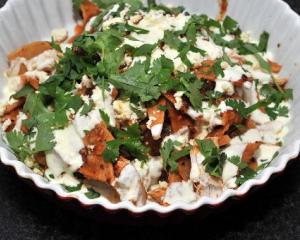Myung Ran Lee (Kelly) from Korea shows how to make bibimbap (mixed rice).
However, in Dunedin she learnt English then studied cooking and culinary arts at Otago Polytechnic, winning a scholarship after her first year.
Korean family meals usually consist of rice, a soup and five to 10 side dishes, more if it's a special occasion, she said.
Bibimbap is a quick family dish that mixes all the ingredients together. It can be put together from whatever vegetables you have, a little beef or other meat, an egg, gochujan (hot pepper paste) and sesame oil and seeds.
Quantities vary depending on how many people you are feeding and how many varieties of vegetables you have.
Bibimbap (mixed rice)
Vegetables (choice of mushrooms, sliced cucumber, sliced zucchini, bean sprouts, spinach, grated carrot, onion, spring onions, daikon, gosari (bracken fern stems- a Korean specialty)
a little beef mince marinated and cooked with garlic, soy sauce and honey
an egg fried in a non-stick pan
sesame oil
sesame seeds
gochujan, (fermented hot pepper paste)
soy sauce (optional)
sugar (optional)
Method
Prepare the vegetables you are using separately:
Steam spinach and squeeze out excess water. Chop and mix with a little salt if desired, and sesame oil and seeds.
Steam bean sprouts until just cooked but still crunchy. Drain and mix with a teaspoon of finely sliced spring onion and a teaspoon of sesame seeds.
Stir-fry sliced mushrooms with soy sauce, a pinch of sugar, sesame oil and sesame seeds.
Slice the zucchini into ribbons and stir-fry with salt and sesame seeds.
Grate the carrot and cook very briefly.
Slice cucumber and wash.
Slice and fry the onion in a little oil until translucent.
To serve, put cooked rice in a bowl. Arrange the vegetables on top - Kelly used courgette, onions, carrot and gosari which she had in the fridge. Add a little cooked meat, sprinkle a little soy sauce over, then add a tablespoon of gochujan (fermented hot pepper paste) and top with a fried egg. Drizzle a little sesame oil over and sprinkle with sesame seeds.
Before eating, mix everything together well.
Alternative version for winter: heat a little oil in the bottom of a pan, add the rice and press down well. Add the vegetables and meat as above and top with a raw egg. Cover with a lid and allow to cook on low heat for 5-7 minutes until the rice at the bottom is crispy and the egg is beginning to set. Add gochujan and mix well.
Serve with a bowl of miso soup alongside. This is usually eaten with a spoon rather than chopsticks.
Tips
• Garlic, spring onions, sesame oil and seeds are used widely in Korean cooking.
• The vegetables can be prepared the night before and the dish assembled quickly when you get home from work. Or you can use leftovers.
• Because of the long cold winters in Korea, people had to preserve food to last them when fresh food was not available. Kelly's mother and grandmother used to get together with friends and make large quantities of kimchi, gochujan, miso and soy sauce each year. There are special fridges available in Korea that hold such condiments at the right temperature to ferment them. Now most people buy them instead of making them.
• Gochujan, Korean fermented hot pepper paste, is available from some Asian supermarkets.
• Instead of bean sprouts Kelly used gosari, bracken fern stems, a traditional delicacy in Korea, which a friend had gathered and dried. She soaked them in water, drained and stir-fried them with garlic, spring onion and sesame seed oil.
• Thanks to Afife Harris and Centre City New World.
Seasons - By Alison Lambert - Available for purchase now!

The Otago Daily Times and Alison have collaborated to bring you her first cookbook – Seasons.
This book is the ultimate year-round cookbook. Seasons is filled with versatile recipes designed to inspire creativity in the kitchen, offering plenty of ideas for delicious accompaniments and standout dishes that highlight the best of what each season has to offer.
$49.99 each. Purchase here.
$44.99 for ODT subscribers. Get your discount code here.








